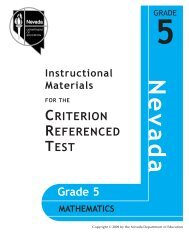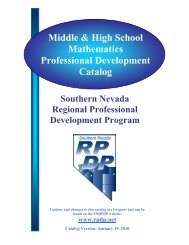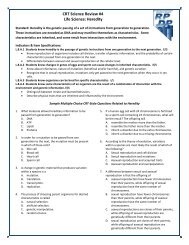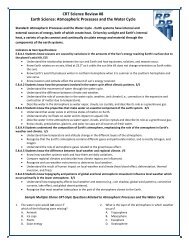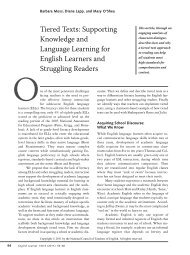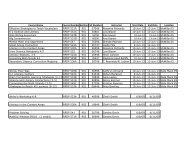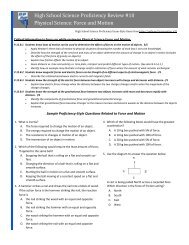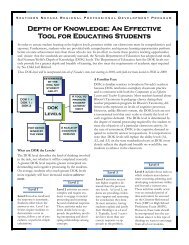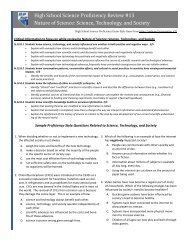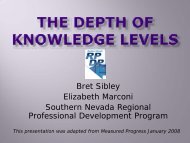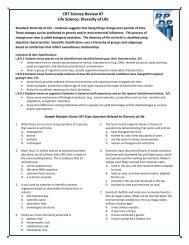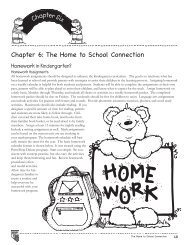Download - RPDP
Download - RPDP
Download - RPDP
You also want an ePaper? Increase the reach of your titles
YUMPU automatically turns print PDFs into web optimized ePapers that Google loves.
More Than Just<br />
Multiple Choice!<br />
by Kathy Dees<br />
The term “assessment” is defined in the NCTM Assessment<br />
Standards as “the process of gathering evidence about<br />
a student’s knowledge of, ability to use, and disposition<br />
toward mathematics and of making inferences from that<br />
evidence for a variety of purposes.” (NCTM,1995,p.3).<br />
Assessment can and should happen every<br />
day as an integral part of instruction. If one<br />
restricts their view of assessment to tests and<br />
quizzes they will miss seeing how assessment<br />
can inform instruction and help students grow.<br />
Several formative approaches that include<br />
performance-based tasks, writing, observations<br />
of students solving problems, and student<br />
diagnostic interviews.<br />
Performance-based tasks are good problem<br />
solving activities that are similar to the student’s<br />
current mathematics instruction. A task should<br />
promote learning and allow every student in the<br />
class to demonstrate their knowledge.<br />
Examples:<br />
Grades (K-1): Joseph has 5 cookies, Maria<br />
has 3, and Frankie has 4. They<br />
want to share them equally. How<br />
will they do it? Draw a picture to<br />
help explain your answer.<br />
Grades (3-5): Kate counted 15 sandwiches<br />
left from the whole batch that her<br />
mother made for the class party.<br />
Her mother asked, “If the students<br />
already ate two-fifths then how<br />
many sandwiches did I make?”<br />
Writing is both a learning and assessment tool<br />
in the mathematics classroom today. Having<br />
the students write about their own ideas in their<br />
own words can offer a chance for a teacher<br />
to assess their conceptual understanding.<br />
Writing can show evidence of student thinking<br />
more than a multiple choice test. Writing also<br />
provides a backup for students who have trouble<br />
verbalizing their mathematical understanding if<br />
they are encouraged to read entries to the class.<br />
Example:<br />
After you solved the problem today how<br />
were you sure you had the correct<br />
answer?<br />
Teachers can gather data about their students<br />
every day through observation. When teachers<br />
systematically record this information they<br />
can document mathematical understanding in<br />
such areas as problem solving, representation,<br />
reasoning, and communication. Depending<br />
upon the teacher’s style, there are several ways<br />
to record information. The teacher can keep<br />
anecdotal notes where cards for each individual<br />
student are taped on a flip chart or clip board<br />
and the teacher records observations for five<br />
students a day. An observation rubric can also<br />
be used to check for concept understanding<br />
for each student. A check list for the whole<br />
class can also be a quick way to gather data.<br />
All these methods can be used to guide the<br />
teacher’s instruction for both short and long term<br />
goals for mathematics instruction.<br />
During diagnostic interviews, the teacher<br />
gives the students a problem, and asks them<br />
to verbalize their thinking about the concept.<br />
The discussion should center on the concepts<br />
currently being taught in class. The teacher’s<br />
role is to ask questions to find out what students<br />
know and where they still have misconceptions.<br />
During these interviews, the teacher has the<br />
opportunity to redirect or reinforce the student’s<br />
thinking and their strategies.<br />
All these methods of formative assessment can<br />
measure a student’s understanding of concepts,<br />
procedures, and mathematical processes and<br />
can be used to guide instruction immediately<br />
and provide learning opportunities for students.<br />
Article: Leatham, K.R., Lawrence, K., &<br />
Mewborn, D. (2005). Getting started with<br />
open-ended assessment. Teaching Children<br />
Mathematics, 11(8), 413-419.



